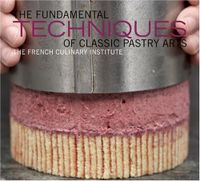Advertisement
Gluten development
Appears in
Flour proteins are hydrated during the mixing of batters and doughs, thereby forming gluten strands. Gases produced during leavening are trapped by the thousands of small, balloonlike pockets in the gluten. Highly elastic, the gluten strands allow the mixture to stretch as the expansion of gases occurs. If too much gluten develops, the mixture will become tough and fixed. Sugar performs an extremely important role as a tenderizing agent during the mixing process.
During mixing, sugar competes with the gluten-forming proteins for the liquid in the mix, which stops the proteins from fully hydrating and slows their development. When the correct amount of sugar is used in proportion to the other ingredients, the gluten will be kept at its maximum elasticity, which, in turn, keeps the gases formed in the leavening process within the interior grid of the dough so the mixture can rise and expand. The final baked product will have a fine texture and a tender crumb, as well as expanded volume and height.


